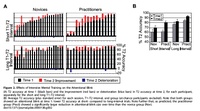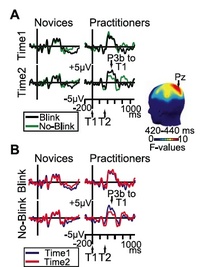Meditation and Learning to Pay Attention

I have talked before about the increasing difficulties that we all have with paying attention.
Over the years we have tried all sorts of things to help people to become better at focusing and controlling their attention, from games, to biofeedback devices to meditation. It is the last of those that seems to be the most effective.
We know from personal experience that paying close attention to one thing can keep us from noticing something else. If we are shown two visual signals half a second apart, we usually miss the second because we are still focused on the first one. We are consciously unaware of the second flash. It is rather like missing something when we blink our eyes, and indeed psychologists call it “attentional blink.” Many psychologists have assumed that attention is something fixed: we can only give a certain amount of attention to one thing at a time before we have to move onto something else or get a kind of brain freeze.
But we have known for some time now that sometimes people do notice the second flash of light, and with practice they can notice it all the time, suggesting that the limitation on seeing the two flashes is not entirely physical, but that it may be possible to bring it under mental control. The first style of meditation that I ever learned was Vipassana, and I well remember being astonished at how quickly my attention and focus began to improve, even when I was not meditating.
Now there is an important new study from the University of Wisconsin-Madison that suggests that attention does not have a fixed capacity, and that it can be improved by directed mental training such as meditation.
The work was done in Richard Davidson’s lab at the University of Wisconsin-Madison School of Medicine and Public Health and the Waisman Center for Brain Imaging and Behavior and published online in the journal PLoS Biology. (This is one of the growing number of open access journals, and for people not yet convinced of the value of open journals have a look at this paper, in which everything is available to you for free.)
The investigators recruited people who were interested in meditation to study whether conscious mental training can affect attention.
They examined the effects of three months of intensive training in Vipassana meditation, which focuses on reducing mental distraction and improving sensory awareness.
Volunteers were asked to look for target numbers that were mixed into a series of distracting letters and quickly flashed on a screen. As subjects performed the task, their brain activity was recorded with electrodes placed on the scalp. In some cases, two target numbers appeared in the series less than one-half second apart – close enough to fall within the typical attentional blink window.

The researchers found that the three months of rigorous training in Vipassana meditation improved people’s ability to detect a second target within the half-second time window. In addition, though the ability to see the first target did not change, the mental training reduced the amount of brain activity associated with seeing the first target.

Because the subjects were not meditating during the test, their improvement suggests that prior training can cause lasting changes in how people allocate their mental resources.
As Richard Davidson says,
“Their previous practice of meditation is influencing their performance on this task. The conventional view is that attentional resources are limited. This shows that attention capabilities can be enhanced through learning.”
The finding that attention is a flexible skill opens up many possibilities. It provides further evidence that attention training is worth examining for attentional problems such as attention deficit hyperactivity disorder.
“When we raise ourselves through meditation to what unites us with the spirit, we quicken something within us that is eternal and unlimited by birth and death. Once we have experienced this eternal part in us, we can no longer doubt its existence. Meditation is thus the way to knowing and beholding the eternal, indestructible, essential center of our being.”
–Rudolf Steiner (Croatian-born Austrian Mystic, Occultist, Social Philosopher, Architect and Founder of Anthroposophy, 1861-1925)
“The moment one gives close attention to anything, even a blade of grass, it becomes a mysterious, awesome, indescribably magnificent world in itself.”
–Henry Miller (American Writer, 1891-1980)
“The path of spiritual attention is not easy, although anyone can make a beginning by trying to understand.”
— Sri Raghavan Iyer (Indian-born Prodigy, Rhodes Scholar, Academic, Philosopher, Theosophist, and, from 1965-1986, Professor of Political Science at the University of California, Santa Barbara, and Father of Pico Iyer, 1930-1995)






